Hello everyone!
I have un problem since two weeks and I d’ont find solution. Help me please ![]() .
.
I have this configuration:
- Arduino Uno with Dragino Shield v1.4 for EU 868 Mhz.
- Dragino Lora Gateway LG01-P
The connection between Dragino gateway and Dragino Shiel is Ok on TTN but I can’t receive data on end device.
My gateway configuration :
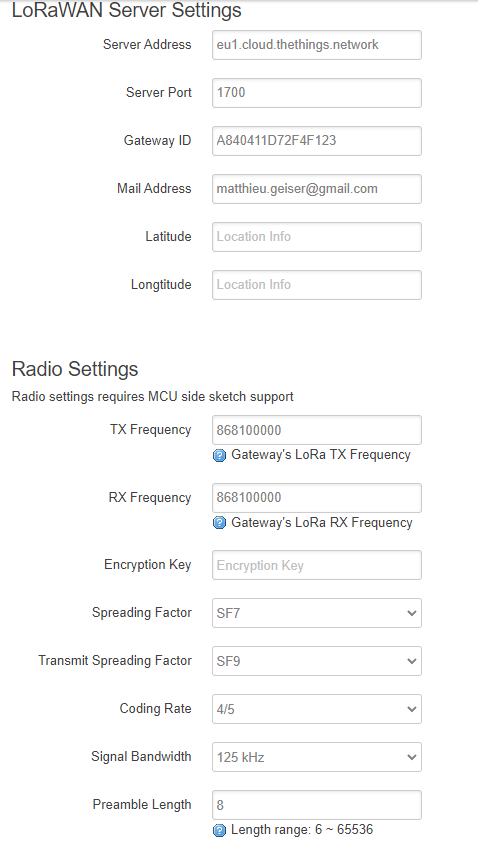
My Gateway configuration on TTN with data from my device
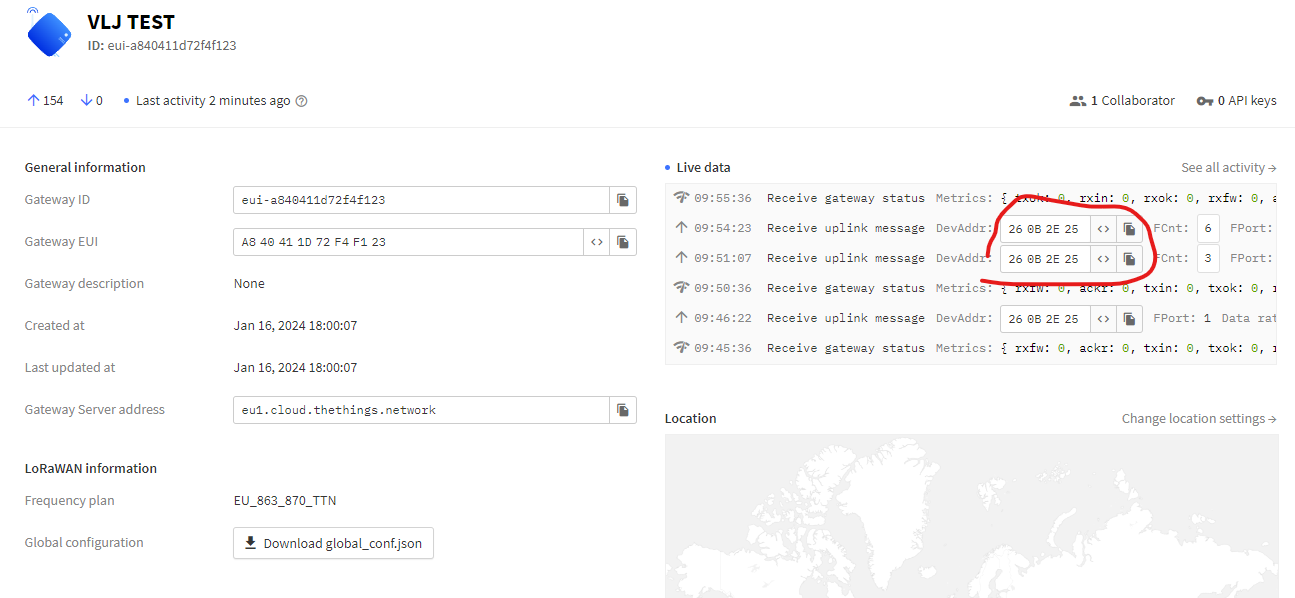
My dragino shield code :
Blockquote
/*******************************************************************************
- Copyright (c) 2015 Thomas Telkamp and Matthijs Kooijman
- Permission is hereby granted, free of charge, to anyone
- obtaining a copy of this document and accompanying files,
- to do whatever they want with them without any restriction,
- including, but not limited to, copying, modification and redistribution.
- NO WARRANTY OF ANY KIND IS PROVIDED.
*H - This example sends a valid LoRaWAN packet with payload "Hello,
- world!", using frequency and encryption settings matching those of
- the (early prototype version of) The Things Network.
- Note: LoRaWAN per sub-band duty-cycle limitation is enforced (1% in g1,
- 0.1% in g2).
- Change DEVADDR to a unique address!
- See http://thethingsnetwork.org/wiki/AddressSpace
- Do not forget to define the radio type correctly in config.h.
- Required Library:
- Require Hardware:
-
- LoRa Shield + Arduino
-
- LoRa GPS Shield + Arduino
-
- LoRa Mini etc.
*******************************************************************************/
- LoRa Mini etc.
#include <lmic.h>
#include <hal/hal.h>
#include <SPI.h>
// LoRaWAN NwkSKey, network session key
// This is the default Semtech key, which is used by the prototype TTN
// network initially.
//ttn
static const PROGMEM u1_t NWKSKEY[16] = { 0x46, 0xFE, 0x09, 0x93, 0xC2, 0x43, 0x94, 0x81, 0x01, 0xD1, 0x56, 0x65, 0xE0, 0x13, 0x14, 0x53 };
// LoRaWAN AppSKey, application session key
// This is the default Semtech key, which is used by the prototype TTN
// network initially.
//ttn
static const u1_t PROGMEM APPSKEY[16] = { 0xF1, 0x02, 0x5A, 0xD5, 0x43, 0x6F, 0x41, 0xD8, 0x84, 0x4A, 0xE0, 0xC1, 0xB9, 0x95, 0x9F, 0x43 };
//
// LoRaWAN end-device address (DevAddr)
// See http://thethingsnetwork.org/wiki/AddressSpace
// ttn
static const u4_t DEVADDR = 0x260B2E25;
// These callbacks are only used in over-the-air activation, so they are
// left empty here (we cannot leave them out completely unless
// DISABLE_JOIN is set in config.h, otherwise the linker will complain).
void os_getArtEui (u1_t* buf) { }
void os_getDevEui (u1_t* buf) { }
void os_getDevKey (u1_t* buf) { }
static uint8_t mydata = “abcdefg”;
static osjob_t initjob,sendjob,blinkjob;
// Schedule TX every this many seconds (might become longer due to duty
// cycle limitations).
const unsigned TX_INTERVAL = 60;
// Pin mapping
const lmic_pinmap lmic_pins = {
.nss = 10,
.rxtx = LMIC_UNUSED_PIN,
.rst = 9,
.dio = {2, 6, 7},
};
void do_send(osjob_t* j){
// Check if there is not a current TX/RX job running
if (LMIC.opmode & OP_TXRXPEND) {
Serial.println(“OP_TXRXPEND, not sending”);
} else {
// Prepare upstream data transmission at the next possible time.
LMIC_setTxData2(1, mydata, sizeof(mydata)-1, 0);
Serial.println("Packet queued");
Serial.println(LMIC.freq);
int result = LMIC_setTxData2(1, mydata, sizeof(mydata)-1, 0);
Serial.print("LMIC_setTxData2 result: ");
Serial.println(result);
}
// Next TX is scheduled after TX_COMPLETE event.
}
void onEvent (ev_t ev) {
Serial.print(os_getTime());
Serial.print(": ");
Serial.println(ev);
switch(ev) {
case EV_SCAN_TIMEOUT:
Serial.println(“EV_SCAN_TIMEOUT”);
break;
case EV_BEACON_FOUND:
Serial.println(“EV_BEACON_FOUND”);
break;
case EV_BEACON_MISSED:
Serial.println(“EV_BEACON_MISSED”);
break;
case EV_BEACON_TRACKED:
Serial.println(“EV_BEACON_TRACKED”);
break;
case EV_JOINING:
Serial.println(“EV_JOINING”);
break;
case EV_JOINED:
Serial.println(“EV_JOINED”);
break;
case EV_RFU1:
Serial.println(“EV_RFU1”);
break;
case EV_JOIN_FAILED:
Serial.println(“EV_JOIN_FAILED”);
break;
case EV_REJOIN_FAILED:
Serial.println(“EV_REJOIN_FAILED”);
break;
case EV_TXCOMPLETE:
Serial.println(“EV_TXCOMPLETE (includes waiting for RX windows)”);
if(LMIC.dataLen) {
// data received in rx slot after tx
Serial.print("Data Received: ");
Serial.write(LMIC.frame+LMIC.dataBeg, LMIC.dataLen);
Serial.println();
}
// Schedule next transmission
os_setTimedCallback(&sendjob, os_getTime()+sec2osticks(TX_INTERVAL), do_send);
break;
case EV_LOST_TSYNC:
Serial.println(“EV_LOST_TSYNC”);
break;
case EV_RESET:
Serial.println(“EV_RESET”);
break;
case EV_RXCOMPLETE:
// data received in ping slot
Serial.println(“EV_RXCOMPLETE”);
break;
case EV_LINK_DEAD:
Serial.println(“EV_LINK_DEAD”);
break;
case EV_LINK_ALIVE:
Serial.println(“EV_LINK_ALIVE”);
break;
default:
Serial.println(“Unknown event”);
break;
}
}
void setup() {
Serial.begin(9600);
while(!Serial);
Serial.println(“Starting”);
#ifdef VCC_ENABLE
// For Pinoccio Scout boards
pinMode(VCC_ENABLE, OUTPUT);
digitalWrite(VCC_ENABLE, HIGH);
delay(1000);
#endif
// LMIC init
os_init();
// Reset the MAC state. Session and pending data transfers will be discarded.
LMIC_reset();
//LMIC_setClockError(MAX_CLOCK_ERROR * 1/100);
// Set static session parameters. Instead of dynamically establishing a session
// by joining the network, precomputed session parameters are be provided.
#ifdef PROGMEM
// On AVR, these values are stored in flash and only copied to RAM
// once. Copy them to a temporary buffer here, LMIC_setSession will
// copy them into a buffer of its own again.
uint8_t appskey[sizeof(APPSKEY)];
uint8_t nwkskey[sizeof(NWKSKEY)];
memcpy_P(appskey, APPSKEY, sizeof(APPSKEY));
memcpy_P(nwkskey, NWKSKEY, sizeof(NWKSKEY));
LMIC_setSession (0x1, DEVADDR, nwkskey, appskey);
#else
// If not running an AVR with PROGMEM, just use the arrays directly
LMIC_setSession (0x1, DEVADDR, NWKSKEY, APPSKEY);
#endif
LMIC_setupChannel(0, 868100000, DR_RANGE_MAP(DR_SF12, DR_SF7), BAND_CENTI); // g-band
// Disable link check validation
LMIC_setLinkCheckMode(1);
// TTN uses SF9 for its RX2 window.
LMIC.dn2Dr = DR_SF9;
// Set data rate and transmit power (note: txpow seems to be ignored by the library)
LMIC_setDrTxpow(DR_SF7,14);
// Start job
do_send(&sendjob);
}
void loop() {
os_runloop_once();
}
Blockquote
And my end device configuration on TTN
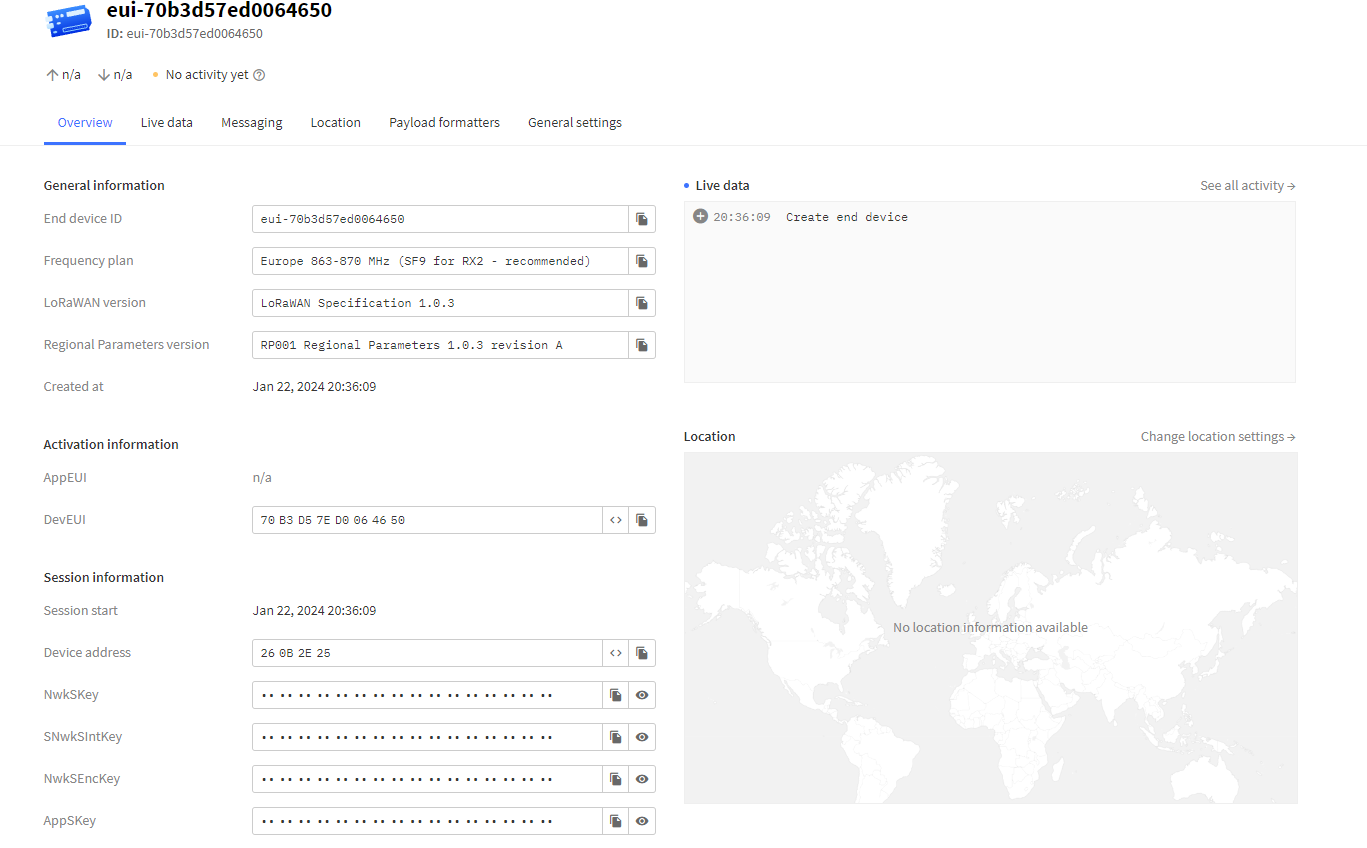
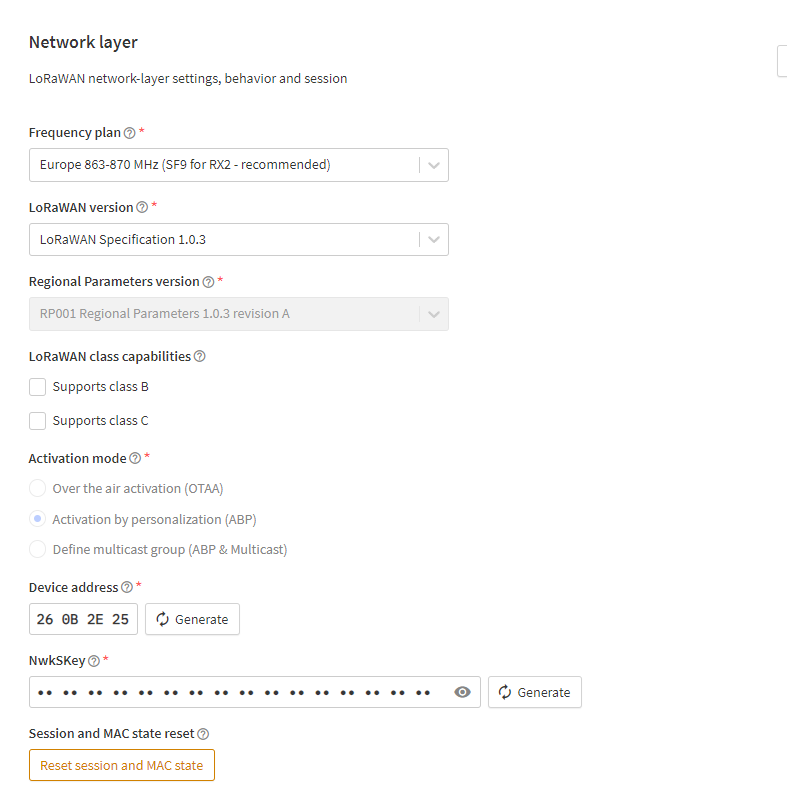
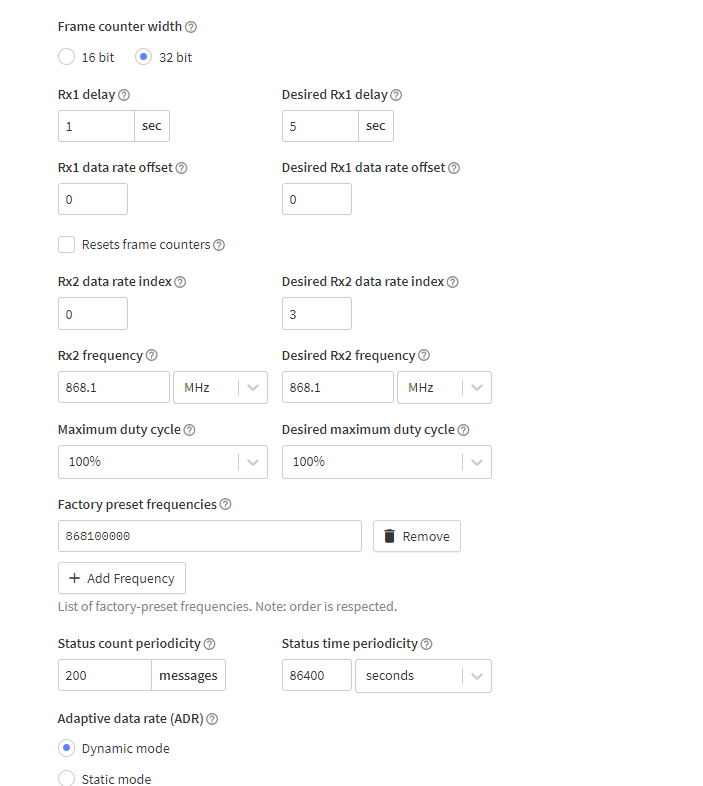
Ty!